Hyacinth Bean: Purple Protein, and More
I’ve never understood the brouhaha over the Hyacinth Bean. Is it edible or is it not?
A monograph in the Journal of Economic Botany (1962, Vol 17:146-153) states on page 150 in reference to the Dolichos lablab:
“For food, usually other varieties of Doliehos which have tender pods are grown, but they require better soil and more water. The bean of Dolichos [lablab] from Angola is eaten in that country, as well as in the vicinity of Val de Pahnas. It was introduced by letting neighbors harvest the pods, of which they could keep half as payment for their labor. Beating the dry pods with a stick will easily free the beans. On the farm, the maize-threshing machine was used. As food, the beans can be prepared in many different ways. They are tasty and eaten like other beans or as a salad, though they have to be cooked longer than ordinary beans.”
Thus the beans are edible. They just have to be cooked longer than other beans, and for good reason. But, the issue does not stop there. In Edible Wild Plants of Eastern North America (Merritt Fernald and Alfried Kinsey 1958) it states on page 256:
“The ornamental hyacinth bean, with showy purple or white flowers in long and interrupted spike-like clusters and large pods about one inch broad, is cultivated chiefly for ornament southward and has escaped to roadsides and thickets northwards to the District of Columbia and Ohio. In the Far East, where it is native, the young foliage, tender young pods and fresh inflorescences are eaten either raw or steamed, while the beans are cooked.”
And in The Encyclopedia of Edible Plants of North America by Dr. Francois Couplan (1998) he states on page 252:
“Originally from tropical Asia, the plant is cultivated on our continent, mostly for ornament, and is found as an escape in southern regions. Young leaves, flowers, and tender, immature pods are edible raw or cooked. The ripe seeds are eaten cooked, either boiled or roasted. In Asia, they are made into noodles. The Hyacinth Bean is cultivated as a vegetable throughout the tropics. Many local species are used as food in tropical Asia, Africa, America and Australia.”
So, what’s the catch? There is one: Mature and dry beans have got a high amount of cyanogenic glycosides in them. Not good for you. Mature or dry beans must not be eaten raw. They have to be cooked. That means boiling soft raw mature beans or roasting as heat drives away the toxin. If they have dried — read they are hard — that means soaking overnight then boiling them a long time in a lot of water. Or, boil unsoaked dry beans in a lot of water twice. Actually, that is what one often has to so with many dried beans. And the older any bean is the longer you have to cook it.
So there is a toxin and some judgement is needed. If I have fresh mature beans — like the green ones right — it’s a long boil in a lot of water or a roast. If I have dry mature beans — also right — it’s a soak and two boils. When you cook the bean it has a very strong bean odor and it looses its color, as a lot of beans do. Very young pods with immature seeds can also be boiled and eaten. Also, do NOT drink or use the boiling water.
Thus the Hyacinth Bean, aka Bonavista Bean, is suitable for the herb pot or the bean pot. Here’s another reason why: The leaves are more than 28% protein, 12% fiber, 7% minerals and 7% fat, eaten freshed or dried. They are an excellent source of iron and magnesium as well as a good source of phosphorus, zinc, copper, and thiamin. Beyond that, sprouts are edible and the cooked root is full of edible starch. You can even ferment the beans as with soy or make tofu. See recipes below.
There are also several cultivars, emphasizing this or that quality, such as red flowers or longer beans or larger roots. Two common ones are Ruby Moon, and White. Two cultivars widely grown as crops are ‘Highworth’ from India, which is early maturing with purple flowers and black seeds. ‘Rongai’, from Kenya, is late-maturing with white flowers and light brown seeds.
We’ve known, in writing, since the 700s that the bean was edible. As mentioned above it was affirmed in 1958 by nationally known experts, mentioned as edible in a scholarly journal in 1962, in various publications since then, and in an encyclopedia in 1998 written by another PhD. And yet, one can find articles less than a year old on the internet saying the bean or the blossom is not edible. Those people just do not do their homework.
Botanically the bean is Dolichos lablab or Lablab purpureus. Dolichos (DOE-lee-kos) is from the Greek “dolikhos” meaning long or elongated. Purpureus (pur-PUR-ee-us) means purple. Lablab (LAB-lab) is the aboriginal name for the bean.
I planted the bean several years ago on a guy-wire. I grew well but not greatly, but I also ignored it to see how it would do.
Green Deane’s “Itemized” Plant Profile
IDENTIFICATION: Purplish green leaves, each with three leaflets, each 3 to 6 inches long, shaped like a broad oval or loose triangle, attractive bean-like flowers, purple, white, rose, reddish in a flower cluster on short stalks along a long main stem. Vine can reach 10 feet long in one season, 30 feet over a years.
TIME OF YEAR:A bsent of a frost or freeze the bean will flower within three months of planting and fruit for most of the year.
ENVIRONMENT: Likes full sun, moist soil, will not tolerate shade.
METHOD OF PREPARATION: Numerous. Young leaves edible fresh or dried, young pods with immature seeds, edible cooked. Flowers and sprouts edible raw or cooked. Older non-dry beans cooked. Dry beans soaked and cooked in two changes of water. Older beans, leaves and pods strong in flavor and texture. Young and tender is better and safer. Roots cooked.
Hyacinth Bean Curry
By Bhakti Satalkar
The list of ingredients for this recipe are indeed long. However, it will not take very long to make the curry.
Ingredients
* 1 cup peeled and soaked hyacinth beans
* 2 onions, chopped
* 3 tomatoes, chopped
* 2 tbsp coconut paste
* ½ tsp ginger paste
* ½ tsp garlic paste
* ½ tsp fennel seeds
* 1 tsp chili powder
* 1 tsp coriander powder
* ¼ tsp turmeric powder
* 1 tbsp oil
* 2 to 3 Curry leaves
* Coriander leaves and mustard seeds for seasoning
* Salt to taste
Method
* In a blender, blend coconut paste and fennel seeds together.
* In a pan, heat oil and add mustard seeds, onions, ginger paste, garlic paste and turmeric powder.
* Saute the onions, till they are translucent.
* Add tomatoes and continue to stir.
* Add salt as per taste and continue to stir.
* After the onions and tomatoes are well cooked, add coriander powder and chili powder to the mixture.
* Now add peeled beans and fry well.
* After 5 to 7 minutes, add coconut and fennel paste and water to the mixture.
* Cover with lid and let it cook for 10 to 12 minutes.
* After the beans are well cooked add chopped coriander leaves and serve hot.
Hyacinth Bean Rice
By Bhakti Satalkar
I often make this rice. This is the recipe I use, when I come back late from work. You can alternately make the rice in the slow cooker as well.
Ingredients
* 1 cup rice
* ¼ cup soaked and peeled hyacinth bean
* ½ tsp chili powder
* ½ tsp turmeric powder
* ½ tsp coriander powder
* 1 tbsp grated coconut
* ½ tsp fennel seeds
* ½ tsp mustard seeds
* 1 tsp oil
* Salt to taste
Method
* In a pot, heat oil.
* When the oil is hot, add mustard seeds to it, followed by turmeric powder, coriander powder, chili powder.
* Stir the mixture well.
* Then add the soaked and peeled hyacinth beans and let it cook for a minute.
* In the meantime grind, coconut and fennel seeds together.
* Add the coconut, fennel paste to the mixture and stir well.
* Add soaked rice and let it cook.
* Serve hot.
Hyacinth Bean, Eggplant in a spicy gravy Recipe
By Srivalli, cooking4allseasons@gmail.com
Ingredients Needed:
Hyacinth beans, 1 cup
Eggplant, – 2 medium
Onions – 2 medium
Tomatoes – 2 medium
Chili powder – 1 tsp
Coriander powder – 1 tsp
Salt to taste
Oil – 2 tsp
Coriander leaves for garnish
For Tempering
Mustard Seeds, Urad Dal – 1/2 tsp
Curry leaves – few
For the ground Masala:
Fresh Coconut – 2 -3 tbsp
Green Chili – 1 – 2 (as per taste)
Fresh Coriander leaves – 2 -3 tbsp
Cloves – 2 -3
Cinnamon – 2″
Ginger Garlic paste – 1/2 tsp

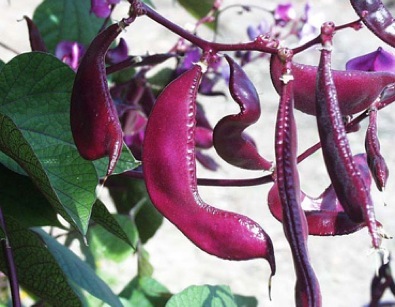
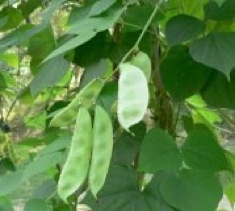
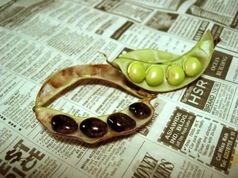
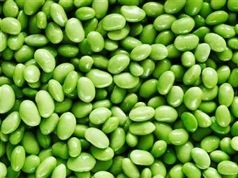
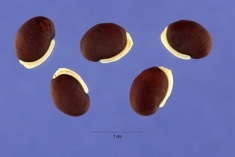

Really useful and clear information. Hyacinth Bean Vines are such beauties and now I’m much clearer on exactly what their status is as edibles. Thank you for taking the time to put together this excellent article.
Everyone should note that ordinary dried kidney beans are also toxic – and must first be soaked, and the soaking water discarded, then boiled to keep from making you sick. I wonder if hyacinth beans are any more toxic than kidney beans?
Dr. Mason shares how several boys wound up in the hospital from eating just a few soaked, but uncooked, kidney beans in this presentation available on YouTube (below). His talks are easy to understand and never boring.
Dr. Paul Mason – ‘How Lectins Impact Your Health…’
https://www.youtube.com/watch?v=mjQZCCiV6iA
These days, a lot of people have heard about lectins, but there are many other toxins and ‘anti-nutrients’ in plants. Some phytochemicals touted as beneficial to us are either toxic, in the wrong form to meet human needs, or prevent the uptake of other nutrients.
– Plant chemicals as antioxidants in the laboratory are usually not bioavailable to human digestion.
– The Omega 3s in plants (except algae/seeweed) are in the wrong form, and only a fraction can be successfully converted.
– There is no Vit A in plants. Instead, plants have carotenoids, known as ‘precursors’ to Vit A, yet in regions where poor people have little or no access to animal-source foods, blindness from Vit A deficiency is not uncommon.
References for the above info available at http://www.diagnosisdiet.com
More fascinating talks on toxins in plants we eat all the time:
Dr. Georgia Ede, MD – ‘…The Risks and Benefits of Eating Plants’
https://www.youtube.com/watch?v=YdRBFiBWQZQ
Dr. George Diggs, PhD – ‘(Food Plant) Toxins in an Evolutionary Context’
https://www.youtube.com/watch?v=fnjX3cZ4q84
Animal digestion is usually better designed to handle the toxins and indigestible fiber in plants. Most large land animals (100 Lbs or more) and many smaller ones are ruminants. Like cattle, they have large vats of microbes that digest what the animals eat, and re-chew and re-swallow. These animals ingest a lot of plant matter, but digest the fatty acids (what we call fats) these microbes produce. And the protein ruminants digest is not from what they eat, but the bodies of the microbes.
Other herbivores are hind-gut fermentors, with huge cecums. Humans have almost none left, and lack the ability to digest cellulose- plant fiber. Hindgut fermenters like rabbits also eat their food twice, in the form of pellets that have already travelled all the way through their digestive tracts. Yum!
As Green Deane frequently points out, some people are more sensitive to the compounds/toxins in some plants than some other people may be. Some people get to the point where they must stop eating plants altogether. They do fine. (L. Amber O’Hearn & Mikhaila Peterson are two well-known examples, along with many groups whose traditional diets included little if any plant matter. Some peoples used plants primarily or only for medicine.)
Most of us can enjoy eating a variety of plants, though we all know that allegries to certain food plants are becoming more common. Peanuts, gluten (a lectin), other nuts, soy, shellfish, etc. Old people tell me that 50-60 years ago, food allergies were rare.
I bought a package of beans, it clearly states that it is not recommended for eating, yet it is one of the species you have noted on here. The difference is that it says “heirloom” on the package. Is it edible still? Or maybe not?? I would appreciate a clarification on this one. It is lablab purpreus, fom botanical interests. I would like to thank you in advance for any reply.
They say “not edible” to cover their legal butts.” Often any treated seed will also say “not edible.”
Does anyone know if these are grown in Sunset zone 9 (Sacramento)? When do they flower and when are the beans generally seen? I’ve got a display project I’m working on and need beans for late July!
I live in the Tampa, FL (zone 9) area and these beans do great here. My neighbors were amazed at how fast they grew, and how beautiful the flowers are. I do water them often. I eat the pods when they are small, cooked in water.
Hyacinth beans should do well in zone 9. They grow well for me in Austin, TX. I live in the N.W. part of Travis county and am probably in zone 8a as I am in a frost pocket. At first I carefully saved seed to plant the next spring. It was totally unnecessary. Seeds that fell off the vine sprouted outside, they came up too early, a frost would kill them, then others would come up, over and over until we were finally frost free. And there was still dried seed pods hanging on some dried vines from the year before. So, I just let them do what they want. They are very easy to control. Just pull them up. They don’t come back. But I bet more seeds will sprout somewhere else.
I live near Sacramento, up in the foothills by Clearlake. I planted Blue Hyacinth bean seeds which I purchased from Park Seed, and the plants have grown, flowered, and produced beans very well. They are VIGOROUS growing vines! and very productive and beautiful.
A friend of mine introduced me to these beans tossed into a salad. I’m not sure how she prepared them, while they were tasty, afterwards I was quite ill, and have determined I’ll not eat them again. However, I do suffer from IBS, so it could just be me.
thanks. we just planted some at the Los Angeles EcoVillage as we are introducing as many perennial edibles as possible. The beautiful plants have begun to set pods. I really appreciate all your research, warnings and recipes.
my question has to do with my animals. I have dogs and cows. would eating the beans make them ill?
Any beans are likely to make a dog sick. Dried beans may even kill it. I had to fence my lima beans to stop my dogs eating the drying seeds from inside the pods. But they aren’t interested in green pods.
The cows will love them; in fact in first world countries, these beans are mainly grown as forage crops.
What about Chickens? any problem with feeding them boiled Lablab?
I grow the scarlet bean vine on my chicken coop. The will eat the plants but will not eat the mature bean, The vines hide my hens, keep them cool and provide a jungle look in the back yard. Bumble bees love to visit too.
Just bought a little hyacinth bean plant (my first) and will be trying it here in West Virginia. Your information was very helpful — and encouraging. Can’t wait to see this bean plant grow and climb up my trellis, then try some edibles from it!
Growing these in a public place entails a responsibility to put up a sign telling people not to eat them raw. They can cause death or kidney destruction if not thoroughly cooked.
Read the whole article
Please, when you say to cook them twice or to roast them, can you say specifically how long? I’m not an accomplished cook but very interested in edible flowers and associated plants. I have some of these growing and they are starting to put out lots of bean pods. Would like to use them but not sure how long a pod is “immature” –specific detail would help. Thx.
We pick and eat these from my mother’s garden. We’ve picked them at different stages but have always cooked them the same–just as we would any other bean, i.e. with seasonings and sausage, in water for a few hours (or a crockpot). My mom has always grown these (she grew up in the islands) but we never knew what the name was until I stumbled across a picture of them on the internet. I guess they’ve matured when the beans inside the pod has gotten hard (?).
Can you tell me please what do you mean by “peeled and soaked?” Do you mean you extract the seeds from a tender bean pod? And then soak them… for how long? At what point is the seed pod young enough to use, or when is it “old?” When you say “a soak and two boils” what do you mean? How long is it soaked? How long is it boiled? I am no experienced cook but would like to try these. Thank you.
I acquired some seeds from a neighbor. Some seem to be already sprouting and it is fall. Can they be planted now in zone 6-7 or will they be viable in the spring? Thank you for the recipes too. Not sure I will eat them though. I like them for their color and beauty, also draw hummingbirds and honey bees.
My mother grows these (as well as other types) beans. We take them out of the pod (didn’t know the leaves and pods were edible), sautee aromatics, seasonings and sausage and throw everything in a crockpot on low for 8 hours. Delish!!
You can eat the whole pod when they are still young and fresh. If they snap when you break them in half they are right to eat. De-vein them as you would any green bean and slice them across into 3 mm slivers beans and all. Heat oil, throw in some mustard seeds add the cut, washed chopped beans and season with salt and red chilli powder. You may choose to close and steam or just keep cooking in low heat for about fifteen minutes. It will give off a divine buttery smell and taste. Best eaten with steamed rice or whole wheat flat breads. Look up recipes for “Avaraikkai” as they are called in Tamil (Southern Indian language). Enjoy!
Thank you Vanita!! I will try your recipe! It’s also nice you gave those guidelines on knowing when the pod is right for eating fresh, because I’m used to regular varieties of climbing beans, but this is the first year I’ve grown hyacinth beans.
Can you tell me if this bean is harmful to dogs?
Are they harmful to dogs?
I have grown these on my front fence for years. They have purple flowers and purple pods and do seem to attract humming birds. I have eaten the young pods raw many times and never felt at all sick. I eat them raw or with hummus or other dips. The color is great in a vegetable tray.
do not sprout and eat it ‘raw’, unless boiled for long time – better so in pressure cooker. Discard the cooking water. The tender beans ( with pods) can be eaten after a good boil. Of all the cultivate old world edible legumes, this one is the most toxic, along with sword beans or hog beans ( Canavalia spp.) .
I’ve been growing different kinds of beans for almost 17 years, I have 2 of these and different color but the the purple one died good thing I saved few seeds before it happened. The strong one is keep on fruiting twice a year since 2001, and I harvest the young shoots, and I wait till the pods get bigger like 5 inches, the pods still flat and crunchy because I don’t like the bulky seeds I like smaller seeds it’s more sweeter plus I usually cook this vegetable mix with the others like eggplant, okra, pumpkin and bittermelon. I don’t get sick eating this hyacinth bean vegetable. This is just a normal day to day food of most asian cultures. I’ve been eating this kind of bean since when I was younger so I’m not worried that I will get sick eating it now. I live in Florida Usa and I know a lot of people are eating this bean you can see them in you tube. I’m swapping asian seeds to friends sometimes ?
Vet informative. Question: The recipes do not mention anything about soak, boil, boil. I assume that this is done in advance of using the recipes. Is that correct?
Oh, and one comment mentioned eating them at the fresj “snap pea” stage with out any concern or need for boiling. Is that safe?
I live in Wisconsin, zone 4, when should I start these beans indoors? I would love to plant them and harvest the beans. We have about a 180 day growing season so any advice would be helpful. Thank you.
Also zone 4 here. I planted the purple hyacinth beans Ruby Moon at the same time as my Scarlet Runner beans. They both bloom up until frost, and were ready for first pick after about 70 days from germination. Germination took about a week or two for both varieties and they were directly sown. Soaking the seeds overnight greatly hastens germination.
Will they grow in the desert southwest, Phoenix AZ? Mild winters, almost never a frost but hot summers, up to 115 now and then.
Thank you for all the information.
In zone 10 and warmer they are perennial plants. However, they will not germinate above 90° and it is not recommended to transplant them. They don’t care for shade, either. Soak seeds overnight before you direct sow them outside. They can be planted every few weeks for a continuous harvest.